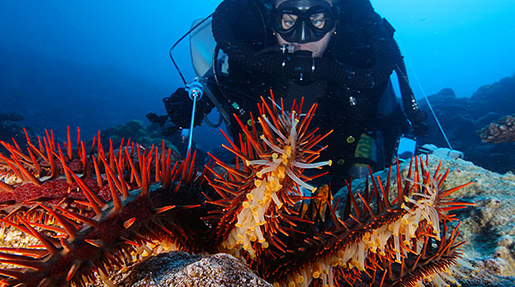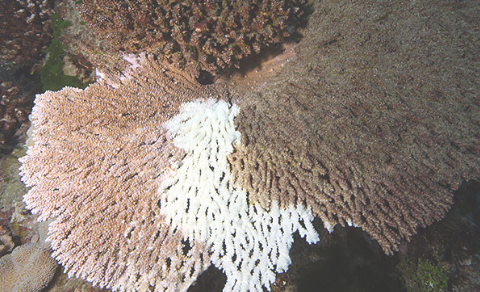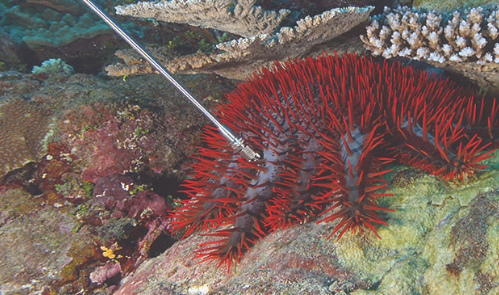Divers remove crown-of-thorns starfish from the islands’ coral reefs
American Samoa is tackling a thorny issue on its nearshore coral reefs. The issue takes the form ofcrown-of-thorns starfish (COTS), prickly critters, known locally as alamea, that voraciously consume the live stony corals that form the reefs’ limestone foundation.
COTS can grow 14 or more inches across and may have as many as 21 arms. Long, stiff spines protruding from the animal’s arms and crown-like central disk (thus the name) contain powerful venom. When a predator—or anyone unfortunate enough to step on or otherwise touch a COTS—gets too close, the spines deliver a painful sting and may also embed in the unwary intruder’s flesh.

Around 2012, the COTS population began to explode. Similar outbreaks in the past destroyed essential fish habitat and caused negative long-term effects on local fisheries.
Land-based pollution and the subsequent runoff of nutrients like nitrogen and phosphorus are believed to cause most COTS outbreaks. Excess nutrients change the ecology of the reef, giving the starfish “a leg up” during the larval stage.
Another theory links the outbreak to the 2009 tsunami, which may have dislodged sediments and stirred up nutrients from the ocean floor. The timing of the outbreak and the fact that today’s mature COTS would have been in the larval stage in 2009 seem to support this possibility.

NOAA’s Coral Reef Conservation Program (CRCP) recently supported the removal of nearly 200 COTS from nearshore reefs around the islands of Tu-tuila and Aunu’u in partnership with the National Marine Sanctuary of American Samoa, the American Samoa Coral Reef Advisory Group, and others. It was the second year of an effort to identify areas with the highest densities of COTS and employ a team of NOAA divers to extract them.
Divers inject the central disk near an arm of each starfish with ox bile, a natural substance that kills the creature but does no harm to the reef. To do so, each diver uses an ox-bile injector—an 18-inch-longmetal tube that houses a syringe, a needle, and enough ox bile to inject up to 100 COTS.

To date, CRCP has supported partner efforts to remove more than 7,000 COTS around American Samoa. The removal effort may be working, since the number of COTS eliminated so far this year was far fewer than the 1,440 removed just last year.
The smaller number found this year still indicates outbreak levels, however. Ongoing monitoring and removal efforts will be necessary to keep COTS numbers low and prevent a rebound in the outbreak. Additionally, a long-term plan to address the threat is being developed with relevant agencies and partners.
A Samoan saying is that “The best thing for an alamea sting is the alamea itself,” which refers to using the COTS’s own venom to treat its sting—a sound concept that modern medicine calls immunotherapy. NOAA’s efforts to hold the COTS population at bay should go far to reduce the creature’s “stinging” effects on the islands’ fragile coral reefs.
Parting Words
NOAA’s Coral Reef Conservation Program supports effective management and sound science to preserve, sustain, and restore valuable coral reef ecosystems for future generations. Other partners involved in the American Samoa COTS removal program include the American Samoa Department of Marine and Wildlife Resources, Papahānaumokuākea Marine National Monument, NOAA Dive Center, and Grey’s Reef National Marine Sanctuary.


